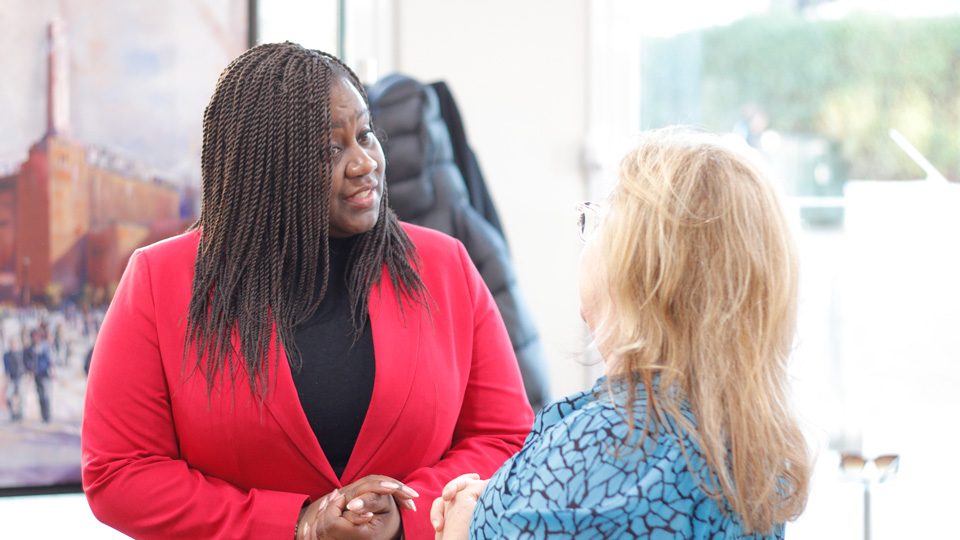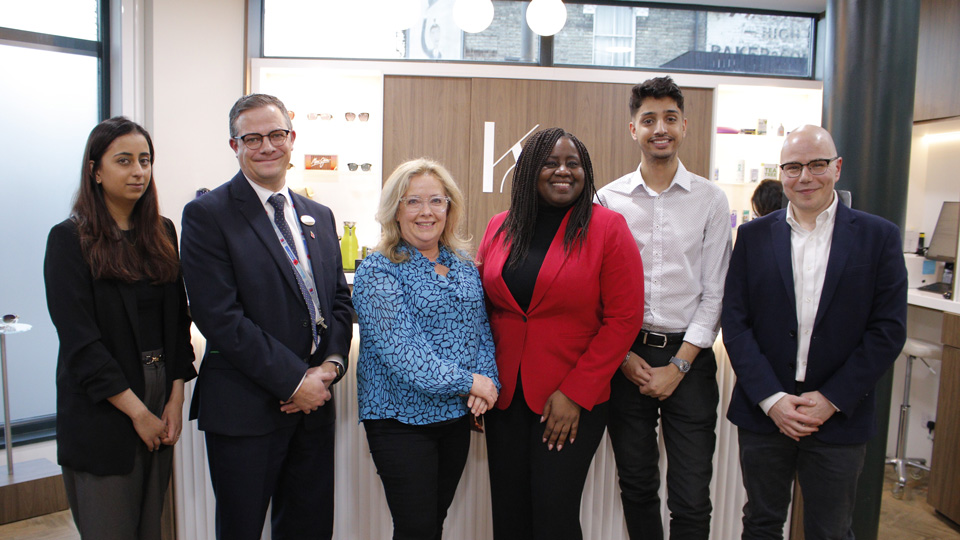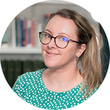- OT
- Professional support
- Optical organisations
- Nine fights for a better optometry world
The roundtable
Nine fights for a better optometry world
Marsha de Cordova MP emphasised the value and potential of High Street optometry during an AOP-hosted roundtable discussion with practitioners in her constituency
The importance of High Street optometry was the focus when Marsha de Cordova, MP for Battersea, met practitioners in her constituency.
With the aim of understanding what the primary eye care situation is like locally, the AOP hosted a practice visit and roundtable discussion with de Cordova and local practitioners in Clapham Junction in January.
In attendance were optometrists Karen Lockyer, who has practised in the constituency since 1994 and owns the eponymous practice where roundtable was hosted; Indy Ghuman, who works at Moorfields Eye Hospital and locums in Battersea; Henna Ali, vice chair of the Merton, Sutton and Wandsworth Local Optical Committee (LOC); Graham Tritton, general manager at Specsavers on Northcote Road, and AOP professional and clinical director, Dr Peter Hampson.
“I really value the role that community optometrists play in delivering eye health care for people, and I’d like to see more of that happening,” de Cordova said, before the gathered practitioners launched into a discussion that encompassed consistency of service, effective triage, integrated care boards (ICB), myopia management funding, and the potential for technology in home monitoring for certain conditions.
So, what challenges – and importantly, what solutions – were identified? OT summarises the key topics of conversation...
1 Consistency of service
Tritton highlighted that if a patient who lives in Chelsea walks into his Clapham Junction Specsavers, they are not entitled to NHS treatment – even though they might live less than two miles away.
“It shouldn’t be post-coded,” he said, noting that “if you have an injury and you arrive at a walk-in centre, you can get looked after.”
De Cordova acknowledged that this disparity is down to the way that eye care services are commissioned through different ICBs. Stepping just a couple of miles out of their local area could mean that a patient is denied NHS services.
Ghuman said that inconsistency is a challenge faced in secondary care optometry, too.
“When we [at Moorfields] receive referrals from lots of different clinics, often it’s quite clunky and we have missing information,” he said. “We have to piece together information ourselves from the patient, because we haven’t got it.”
He added: “It has come from lots of different places: via their GP, directly from their optometry practice, or from a private third-party provider that their NHS care has been outsourced to.”
“It would be really good if there was consistency across the board, so it was easy for the patient to be referred, but also to make our jobs a bit more fluent in the care that we deliver to the patient.”
Ghuman continued: “Often there’s lots of time wasted. If there was coherency between primary and secondary care, there would be better productivity in terms of our time. It would mean we could see more patients and our capacity could be increased.”
One potential solution is digital connectivity, a key AOP policy ask.
Ghuman said: “There is discussion around the digitisation of referrals and making it more connected, not only in the local area, but nationally as well.”
He explained that training in Birmingham, and afterwards working in Manchester and London, has made it clear how service delivery is varied across different geographic areas. In Greater Manchester, he said, there is one system for the entire county.
“What I envisage for the future is more collaborative care throughout England,” Ghuman predicted.
Ali noted that this difference in quality of referrals is even seen across her own LOC area, with variations across the three South West London boroughs that it covers.
“The main challenges revolve around communication between primary and secondary care,” Ali said. “Where a patient may have gone to one practice one year and then two years later to a different practice, if someone has been referred for the same condition, an optometrist wouldn’t know, because there’s no communication. You have repeated referral.”
Three areas of London – Sutton, Kingston and Richmond – do not have electronic referrals in place at all, Ali shared, emphasising: “There’s that inequality, even just in that small area of London.”
Because Sutton does not have electronic referrals, every referral goes through the patient’s GP, she explained, and “that’s frustrating for the GP, because you’re clogging up their time.”
On the other hand, “in Merton, we have the single point of access, where the referrals are triaged. We send an electronic referral, which is triaged by an optometrist. It is then known whether that referral is needed, if there’s more information that’s needed, if that patient can be seen within primary care, or if the case does need to be triaged to a hospital clinic. In Sutton, that wouldn’t occur.”
Ghuman believes that “digitisation, with an electronic referral system, is the most approachable and easiest thing that we can do. It just needs a bit of investment.”
Discussing patients in his stable glaucoma clinic at Moorfields, he added: “Different areas have different ways of doing things, and there’s no continuity of care. We have patients coming from lots of different areas. If they were to go back to their local areas, that eye care would be delivered differently. That’s a shame.”

2 High Street practices have the technology to triage into secondary care quickly and efficiently
Lockyer is unequivocal about the fact that she could take on work from hospital optometry if the funding was in place.
“Ophthalmology is very busy,” she said. “We’re in this perfect position. We have the equipment; we have two consulting rooms. We could triage people, but obviously there is going to be a fee. We’re a big High Street practice, but we’ve got to be remunerated. We can’t be doing it for free.”
Lockyer continued: “I want to deliver clinical excellence, and we could do it in the community, in a nice environment. I’m a very experienced optometrist, and I employ very experienced optometrists. We’re all able to read optical coherence tomography and Optomaps.”
She added: “We had a macula-off retinal detachment recently, and we could send that straight in. It’s very quick, if you have the technology.”
Ghuman believes that the entire keratoconus monitoring clinic at Moorfields “could be digitised and put into the community.”
“If you have a scanner that looks at the front of the eye, and local optometrists are interpreting that or it is sent remotely to the hospital, it means patients can access that care more conveniently in their local area,” he said. “It means capacity is increased and that at the hospital, and we can free up that clinic to see more urgent patients, with more extensive needs.”
3 ICB funding is key to progress
Ali warned that, “in South West London, the [ICB] deficit is growing. Funding is a major issue.”
Optometry First – the model of optometry being the first port of call for all eye conditions – would free up time in ophthalmology clinics, leaving ophthalmologists to see more complex cases, she said.
Community optometrists could potentially see stable glaucoma cases and test for fluid in wet age-related macular degeneration cases, Ali believes – “but obviously, that does come at a cost.”
When it comes to ICBs, de Cordova agreed that, “how we negotiate the best relationship with the Optometry First model is something that needs to be looked at closely.”
Hampson noted that, while having more funding would likely solve the problem, it can also be useful to have a champion within the ICB who understands why eye health should be a priority.
“Obviously, there are competing interests in health,” he said. “What one person prioritises may not be the top priority for another.
“It’s having somebody within each ICB, pushing that message and making sure everybody understands the benefit that it can bring. Without that, they may not understand what could be done. That’s one of the big challenges.”
4 Potential of home-monitoring
At Moorfields there is a technician-led clinic where patients attend once to have their scans and afterwards can do it remotely from home, Ghuman shared.
“In glaucoma, [as an optometrist] you might just measure eye pressure,” he said. “There’s lots of technology already out there that can measure that at home and automatically send it to the clinician.”
He acknowledged that home-monitoring is something that he has seen performed via private clinics at Moorfields, and that this level of technology is unlikely to be possible across the board.
“I’m not saying that the NHS and the Government need to fund all this innovation, but a little bit, I think, would go a long way in terms of the efficiencies that we can deliver, not just at Moorfields in London but also at a national level,” Ghuman added.

5 Stable glaucoma patients could be moved into the community
Ghuman works in a glaucoma clinic at Moorfields, where patients have been moved on from the consultant because they have been deemed to be stable.
Optometrists in the clinic monitor the patient, take scans, and ask about symptoms, Ghuman said.
He believes that this work could be done more locally to the patients’ homes, if a funding model and a referral pathway existed.
He explained that some patients can be with this clinic for years, often at great inconvenience.
One patient had come to Moorfields from Oxford, and was distressed because she had missed her train home, Ghuman said. He explained that his only solution was to write to her GP and ask for a referral to Oxford Eye Hospital instead.
He believes that his time would be better spent seeing more urgent local cases, and that this kind of work should be seen outside the hospital.
“We use all the same equipment. We all have visual field testing equipment; we all have slit lamps. It can be done in the community,” Ghuman said.
6 Delays in confirming NHS contracts are hindering the services that can be provided
Lockyer explained that, despite having moved into her current practice in the autumn of 2023: “I haven’t been able to do NHS sight testing.”
She had an NHS contract down the road at her previous site, she explains, but the lack of a joined-up system means her new location currently cannot take on NHS patients – even though she has been an optometrist in the area for three decades. It means her spacious practice has a large amount of underused capacity.
“I’m sitting here with two consulting rooms, but unless I get that contract, I’m not going to be using the other room, because we just don’t have the volume,” she said.
7 Progress needs to come from the top down
The practitioners all acknowledged that, despite their best intentions, the extension of further and enhanced services and the upskilling of the profession cannot only come from optometrists themselves.
As a practice manager, Tritton revealed that the optometrists in his practice “are chomping at the bit to get more and more involved. They love doing the training; they love seeing all these diverse cases on a day-by-day basis. It’s a resource that is just waiting to go.”
De Cordova agreed, adding that upfront costs would lead to “certain benefit as time goes on.”
Ghuman added: “Practitioners have the skills. They’re eager to develop, they’re eager to study more, such as with independent prescribing.”
“With the changes to education for new optometrists, we’re going more clinical, but we need the way forward, to use that from the top down. We’re here to help.”
8 The need for myopia management funding
Lockyer noted that the NHS currently is not paying enough attention to the need for myopia management interventions.
“We are looking at children, to try and prevent this myopia epidemic,” she said. “In children, we can control or slow down myopia progression. If you don’t slow it down, when they get older you have this whole catastrophe approaching: people with retinal detachments, macular degeneration, glaucoma.”
She added: “Interventions are expensive at the moment. Why should it be that only people who can afford it have the interventions?”
Tritton spoke about a mother who came into his practice with her five-year-old, who was already a high myope.
“We spoke about myopia management and she genuinely couldn’t afford it, which broke her heart,” he said. “She ended up with the grandparents funding it, and we ended up doing it cheaper, just to do what we could. So, it cost us, as well.”
“The NHS can fund it better,” Lockyer believes.
Hampson also emphasised the importance of prevention more widely.
“I think what is important is the wider prevention argument,” he said. “In this case, we’re talking about myopia, but you could remove myopia and say, ‘can we save by spending a little bit more upfront to increase the chances of preventing avoidable sight loss or avoidable eye disease, or catching it sooner?’ I think the prevention message, in general, is probably the really big one.”
De Cordova emphasised that this is why having a national plan in place, as she has proposed with a bill in Parliament, makes logical sense.
“You need a proper plan in place: a national plan, that is implemented and delivered locally, so that there is a consistent approach and everything is joined up, with the right funding attached to it,” she said.
She added: “It would be such a better way of doing things. There will be efficiencies within that. Making use of our community optometrists is crucial.”
9 Better systems come from people power
De Cordova acknowledged that the statistics when it comes to eye health and sight loss are staggering.
“Pretty much anyone you speak to you will know somebody who has had an issue with their eyesight,” she said. “By 2050, they estimate four million people living with sight loss. That’s huge.”
She added: “To try and ensure that we can prevent as much of those avoidable sight conditions as possible is going to be crucial. That’s where you all have a role to play. We have to keep pressing.”
Discussing how practitioners can play their part, she said, “I think it’s important to try and influence locally. It is so important that people raise these issues constantly. I can bang the drum about eye healthcare in my own area, but more of us need to be saying it, because they may take note.
“Look at other diseases, and how they are on everybody’s mind, because people have been talking about it. That’s what we have got to do with eyes.”
Get involved
- The AOP has created a guide to lobbying, to help optometrists who want to get in touch with their local MP to discuss eye care issues. The guidance can be viewed here
- The AOP is also encouraging members to contact their MP as part of its Sight won’t wait campaign. Read more here
- The AOP is ready to support practitioners who would like to host an MP visit at their practice. If you are interested in potentially hosting an MP, get in touch.



Comments (0)
You must be logged in to join the discussion. Log in